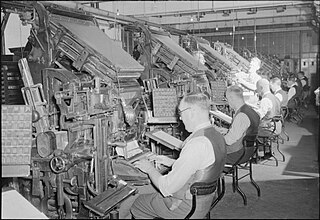
The history of British newspapers begins in the 17th century with the emergence of regular publications covering news and gossip. The relaxation of government censorship in the late 17th century led to a rise in publications, which in turn led to an increase in regulation throughout the 18th century. The Times began publication in 1785 and became the leading newspaper of the early 19th century, before the lifting of taxes on newspapers and technological innovations led to a boom in newspaper publishing in the late 19th century. Mass education and increasing affluence led to new papers such as the Daily Mail emerging at the end of the 19th century, aimed at lower middle-class readers.
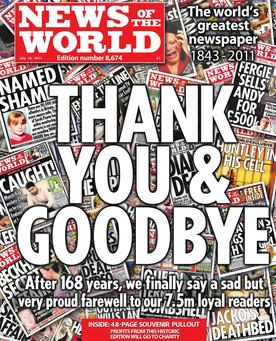
The News of the World was a weekly national "red top" tabloid newspaper published every Sunday in the United Kingdom from 1843 to 2011. It was at one time the world's highest-selling English-language newspaper, and at closure still had one of the highest English-language circulations. It was originally established as a broadsheet by John Browne Bell, who identified crime, sensation and vice as the themes that would sell most copies. The Bells sold to Henry Lascelles Carr in 1891; in 1969, it was bought from the Carrs by Rupert Murdoch's media firm News Limited. Reorganised into News International, a subsidiary of News Corporation, the newspaper was transformed into a tabloid in 1984 and became the Sunday sister paper of The Sun.

Paul Gustave Louis Christophe Doré was a French printmaker, illustrator, painter, comics artist, caricaturist, and sculptor. He is best known for his prolific output of wood-engravings illustrating classic literature, especially those for the Vulgate Bible and Dante's Divine Comedy. These achieved great international success, and he became renowned for printmaking, although his role was normally as the designer only; at the height of his career some 40 block-cutters were employed to cut his drawings onto the wooden printing blocks, usually also signing the image.

The Daily Chronicle was a left-wing British newspaper that was published from 1872 to 1930 when it merged with the Daily News to become the News Chronicle.

The Illustrated London News, founded by Herbert Ingram and first published on Saturday 14 May 1842, was the world's first illustrated weekly news magazine. The magazine was published weekly for most of its existence, switched to a less frequent publication schedule in 1971, and eventually ceased publication in 2003. The company continues today as Illustrated London News Ltd, a publishing, content, and digital agency in London, which holds the publication and business archives of the magazine.
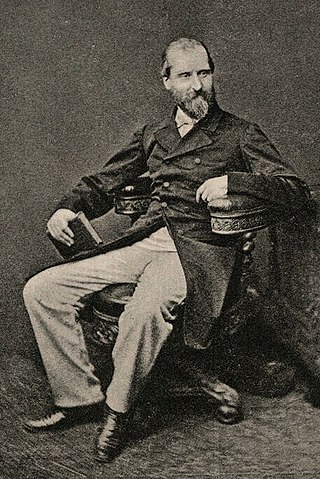
Henry Richard Vizetelly was a British publisher and writer. He started the publications Pictorial Times and Illustrated Times, wrote several books while working in Paris and Berlin as correspondent for the Illustrated London News, and between 1880 and 1890, ran a publishing house in London, Vizetelly & Company.

John Cassell was an English publisher, printer, writer and editor, who founded the firm Cassell & Co, famous for its educational books and periodicals, and which pioneered the serial publication of novels. He was also a well-known tea and coffee merchant and a general business entrepreneur who, through the mutation of his eponymous product 'Cazzoline', was the origin of the word 'gasoline'. A fervent Christian, he campaigned throughout his life for the temperance movement in Britain, and for the reduction of taxes on publishing. He was a social reformer who recognised the importance of education in improving the life of the working class, and whose many publications, both magazines and books, brought learning and culture to the masses.
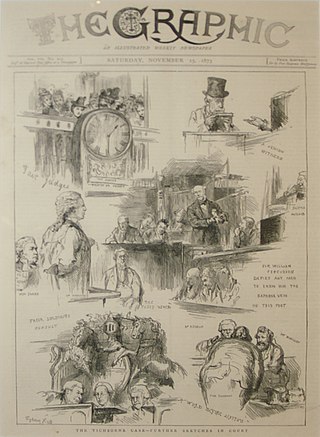
The Graphic was a British weekly illustrated newspaper, first published on 4 December 1869 by William Luson Thomas's company Illustrated Newspapers Ltd. Thomas's brother Lewis Samuel Thomas was a co-founder. The premature death of the latter in 1872 "as one of the founders of this newspaper, [and who] took an active interest in its management" left a marked gap in the early history of the publication. It was set up as a rival to the popular Illustrated London News.
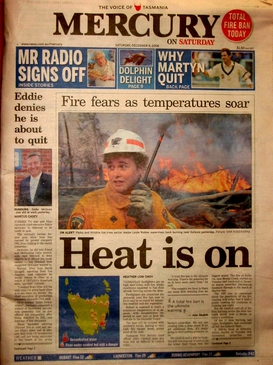
TheMercury is a daily newspaper, published in Hobart, Tasmania, Australia, by Davies Brothers Pty Ltd, a subsidiary of News Corp Australia, itself a subsidiary of News Corp. The weekend issues of the paper are called Mercury on Saturday and Sunday Tasmanian. The current editor of TheMercury is Craig Herbert.
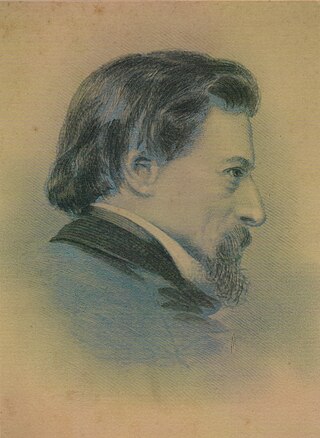
Charles Henry Bennett was a British Victorian illustrator who pioneered techniques in comic illustration.

The Boston Evening Transcript was a daily afternoon newspaper in Boston, Massachusetts, published for over a century from July 24, 1830, to April 30, 1941.

Herbert Ingram was a British journalist and politician. He is considered the father of pictorial journalism through his founding of The Illustrated London News, the first illustrated magazine. He was a Liberal politician who favoured social reform and represented Boston for four years until his early death in the shipwreck of the Lady Elgin.

The Penny Illustrated Paper and Illustrated Times was a cheap (1d.) illustrated London weekly newspaper that ran from 1861 to 1913.
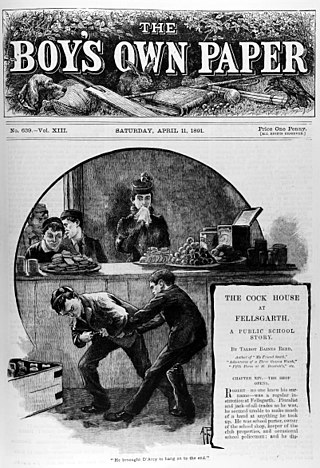
Magazines intended for boys fall into one of three classifications. These are comics which tell the story by means of strip cartoons; story papers which have several short stories; and pulp magazines which have a single, but complete, novella in them. The latter were not for the younger child and were often detective or western in content and were generally greater in cost. Several titles were published monthly whereas the other two categories were more frequent.

Robert Howlett was a British pioneering photographer whose pictures are widely exhibited in major galleries. Howlett produced portraits of Crimean War heroes, genre scenes and landscapes. His photographs include the iconic picture of Isambard Kingdom Brunel which was part of a commission by the London-based weekly newspaper Illustrated Times to document the construction of the world's largest steamship, the SS Great Eastern.

Lloyd's Weekly Newspaper, called the Sunday News after 1924, was an early Sunday newspaper in the United Kingdom, launched in 1842., ceased publication in 1931.

The Stamp Act 1712 was an act passed in the Kingdom of Great Britain on 1 August 1712 to create a new tax on publishers, particularly of newspapers. Newspapers were subjected to tax and price increased. The stamp tax was a tax on each newspaper and thus hit cheaper papers and popular readership harder than wealthy consumers. It was increased in 1797, reduced in 1836 and was finally ended in 1855, thus allowing a cheap press. It was enforced until its repeal in 1855. The initial assessed rate of tax was one penny per whole newspaper sheet, a halfpenny for a half sheet, and one shilling per advertisement contained within. The act had a potentially chilling effect on publishers; Jonathan Swift was a frequent publisher of newspapers, and complained in a letter about the new tax. Other than newspapers, it required that all pamphlets, legal documents, commercial bills, advertisements, and other papers issued the tax. The tax is blamed for the decline of English literature critical of the government during the period, notably with The Spectator ending the same year of the tax's enactment. It would see increasingly greater taxes and wider spectrum of materials affected until its repeal in 1855.
The history of journalism in the United Kingdom includes the gathering and transmitting of news, spans the growth of technology and trade, marked by the advent of specialised techniques for gathering and disseminating information on a regular basis. In the analysis of historians, it involves the steady increase of the scope of news available to us and the speed with which it is transmitted.

Taxes on knowledge was a slogan defining an extended British campaign against duties and taxes on newspapers, their advertising content, and the paper they were printed on. The paper tax was early identified as an issue: "A tax upon Paper, is a tax upon Knowledge" is a saying attributed to Alexander Adam (1741–1809), a Scottish headmaster.

John C. Francis was an English publisher. He was known particularly as an activist and campaigner against the taxes on knowledge.



















